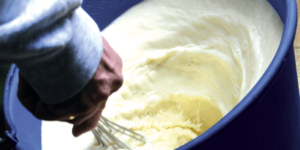Innovation at the Denkavit USA Plant
Despite such uncertain and challenging times, we have kept our employees and continued to grow and invest throughout the pandemic, allowing us to adapt to the new world we live in today as a dairy industry. The process started by looking at incoming raw material costs and what could be done to lower them. Since the plant has a spray dryer, liquid raw materials were a strategic choice. Additionally, liquid raw materials provide fresher materials at a lower cost than dried powders.
 Denkavit USA Plant Manager, Charlie Balko, gives us insight on the new tanks recently installed in Auburn, NY. “As one Team worked on procuring different sources of liquid protein, another team worked on what facility changes would be needed to maximize the savings these liquids could supply. To improve product quality and lower production costs we invested in 3 major projects:
Denkavit USA Plant Manager, Charlie Balko, gives us insight on the new tanks recently installed in Auburn, NY. “As one Team worked on procuring different sources of liquid protein, another team worked on what facility changes would be needed to maximize the savings these liquids could supply. To improve product quality and lower production costs we invested in 3 major projects:
1. Optimization of the evaporator
2. Improvements in our wet blend process
3. The addition of new tanks for liquid streams
Optimization of the evaporator
Dairy proteins are susceptible to breaking down (denaturing) due to heat, however, heat is required to evaporate (condense) them raising their solids level. Our evaporator was optimized in preparation to further stabilize the process when evaporating different liquid streams. This eliminates the possibility of denaturing proteins and allows for a more consistent process.
Improvements in the wet blend
A wet Blend is the area of the plant where the liquids and fats come together before being sent to the spray dryer. This process was evaluated by a professional engineering party to provide the safest possible working environment for our employees, maintain the quality of our product, and in the most efficient manner economically.
The addition of new tanks
During an internal raw material study, different liquid streams were identified by cost and protein levels. All of these would be delivered cold at 35 to 40 °F and needed to be stored that way until used. After evaporation, they would need to be kept hot. Our existing tank layout did not have the heating and cooling capabilities that were needed for liquid streams. From this study, it was decided to add 5 new tanks with temperature control.




